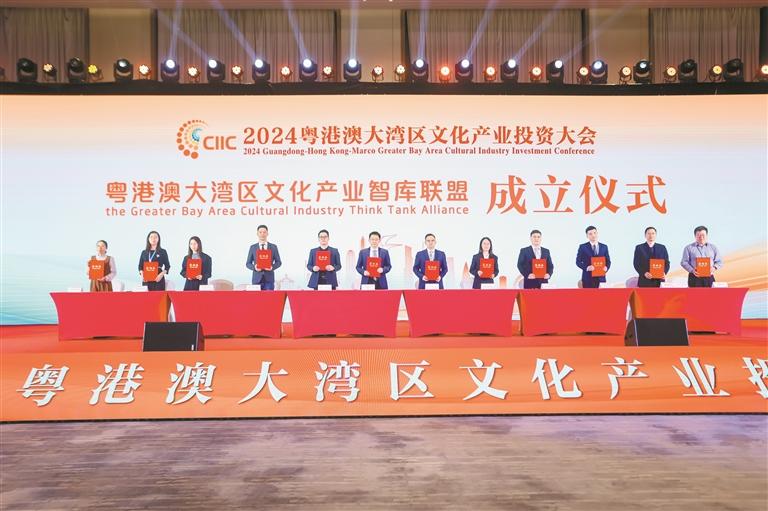SUNTZU Executive Search Learns: The 2024 Greater Bay Area Cultural Industry Investment Conference Held in Guangzhou
The 2024 Greater Bay Area Cultural Industry Investment Conference was successfully held from November 20 to 22 at the Xianglan Guanzhou Hotel on Bio-Island in Guangzhou’s Huangpu District. With the theme “Leading the Bay Area with Cultural Finance, Driving Growth with Industry and Technology,” the conference aimed to establish a national-level platform for cultural finance branding, promote the integration of culture, technology, and finance, and stimulate new momentum in the cultural industry, injecting vitality into high-quality economic development.

1. Organizers and Activities
The conference was organized under the guidance of the Publicity Department of the Guangdong Provincial Party Committee, the Provincial Financial Office, the Department of Culture and Tourism, and the Provincial Radio and Television Bureau. Co-hosted by the China Cultural Industry Investment Fund and the Guangdong-Hong Kong-Macao Greater Bay Area Cultural and Creative Industry Promotion Association, the event featured a rich array of activities. These included the main conference on cultural industry investment, investment release sessions, and matchmaking meetings. Special sessions focused on trending topics such as Guochao (modern designs inspired by Chinese heritage), mergers and acquisitions, digital culture, Guangdong technology finance, and cultural exports.
Reports such as the 2024 Annual Cultural Industry Investment Report and the 2024 Greater Bay Area Cultural Industry Investment Trend Report were released during the conference. Industry experts shared their practical experiences, providing attendees with valuable insights.
2. Cultural Industry Growth
The Greater Bay Area’s cultural industry boasts a massive scale and robust growth momentum, especially in emerging sectors. Over the past five years, the cumulative financing for the region’s cultural industry reached approximately RMB 52.82 billion, demonstrating dynamic investment and financing activity. The conference also announced seven new innovative cultural investment funds focusing on the “culture + technology” sector, prioritizing growth-stage enterprises and projects.
Emerging Trends in the Cultural Industry
1. Integration of Technology and Culture
Rapid advancements in technology are empowering the cultural industry at an unprecedented pace, enhancing efficiency and opening up creative possibilities. Virtual reality (VR) has been employed in immersive museum exhibitions, while AI-powered tools like animation rendering are revolutionizing film production and gaming, elevating both content quality and user experience. These areas are becoming hotspots for capital investment, underscoring the expansive potential of culture-tech integration.
2. Synergy Between Culture and Tourism
The convergence of culture and tourism, supported by government policies, is creating new opportunities. Guangzhou’s “nighttime economy” model, exemplified by projects like the Guangzhou Tower light show, has not only attracted visitors but also garnered significant investments. These successful cases are serving as benchmarks for other regions seeking cultural industry upgrades.
3. Rise of AIGC (AI-Generated Content)
The advent of AIGC is bringing a futuristic and tech-driven edge to the cultural industry. AI-powered tools for writing, music composition, and video editing are dramatically increasing content production efficiency. Industry reports forecast that the AIGC sector will generate over RMB 100 billion in revenue by 2025 and reach a trillion-yuan market scale within a decade. This trend is capturing the attention of investors and driving revolutionary changes in content creation.
4. Expansion of Digital Creative Industries
Micro-dramas, live streaming, and online music are flourishing, offering diverse cultural consumption options. Short-video platforms are leveraging algorithms to promote high-quality content, providing visibility for small-scale creators. This model not only enhances audience reach but also presents investors with profitable avenues for rapid growth.
5. Cultural “Intelligent” Manufacturing
The integration of extended reality (XR) technologies like VR and AR with cultural creativity is deepening. For instance, AR-guided tours in Greater Bay Area attractions provide interactive experiences, significantly enhancing visitor engagement and spending. Additionally, humanoid robots equipped with advanced intelligent systems are emerging as highlights in theme parks and exhibitions, reflecting the innovative potential of cultural manufacturing.
6. New Opportunities in Cultural Consumption
Technologies such as digital twins and VR are unlocking more possibilities in the cultural and tourism industries. Applications like “cloud tourism” enable users to virtually explore iconic Bay Area attractions from the comfort of their homes, creating a new hybrid consumption model. These advancements are drawing substantial investments and fostering ongoing innovation in cultural consumption.
Regional Investment Dynamics
The cultural investment landscape in the Greater Bay Area exhibits notable geographic concentration. Shenzhen and Guangzhou have become the most active cities for investment and financing, supported by their robust technological ecosystems, cultural resources, and talent pools. These cities serve as core engines driving the region’s cultural industry development. Furthermore, the Bay Area has established a multi-tiered financing market, including capital markets, cultural industry funds, and venture capital funds, offering flexible financial support for enterprises of various types and sizes.
From technological integration to regional advantages, the Greater Bay Area’s cultural industry demonstrates immense investment potential and vitality. This sector not only provides new growth avenues for cultural enterprises but also bridges the gap for capital seeking high-quality projects. As technological advancements and policy support continue to strengthen, the cultural industry in the Greater Bay Area is poised to unlock its full potential and embrace a more prosperous future.

Comments are closed